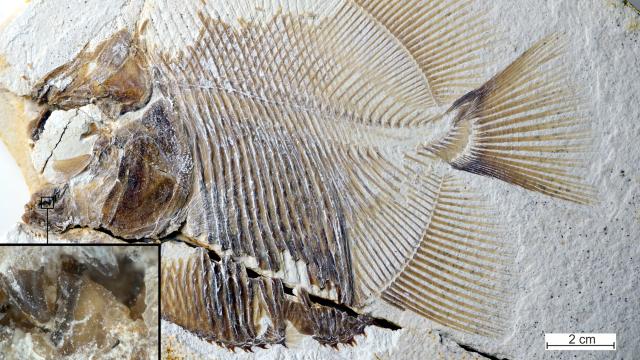Piranha-like creatures capable of biting chunks of flesh from their victims appeared some 150 million years ago, according to new research.
Introducing Piranhamesodon pinnatomus — the oldest known flesh-eating ray-finned bony fish, a family of fish that today includes trout, grouper and cod.
During the late Jurassic, around 150 million years ago, sharks (which are cartilaginous fish) and turtles were capable of slicing into flesh with their teeth. But bony fish, it was assumed, could only eat plankton and crushed shells, or swallow their prey whole.
The discovery of P. pinnatomus shows there was at least one flesh-slicing species around during this time period. The details of this finding were published today in Current Biology.
The nearly complete fossil of this oddly piranha-like fish was discovered in German limestone deposits that are 150 million years old.
“At that time, the area which now is southern Germany was occupied by a shallow tropical sea dotted with small sun-bathed islands, covered by a probably sparse vegetation of ferns and cycads on which exotic animals lived: Numerous insects, lizards, small dinosaurs and the early bird Archaeopteryx,” Martina Kölbl-Ebert, a co-author of the study and a researcher at Jura-Museum Eichstätt, told Gizmodo.
“In the sea there were sponge reefs as well as small coral reefs. There were numerous invertebrate species such as ammonites, squids or crustaceans, but also many different fish and marine reptiles.”
The newly described species is unique in that it features distinctly piranha-like teeth, which Kölbl-Ebert says it likely used to bite off chunks of flesh from other fish.
Remarkably, Kölbl-Ebert, along with her co-author David Bellwood from James Cook University, found evidence to prove this. Fish fossils uncovered in the same limestone deposit had wounds consistent with bite marks, such as chunks missing from fish fins, perhaps caused by a creature very much like P. pinnatomus.
“This is an amazing parallel with modern piranhas, which feed predominantly not on flesh but the fins of other fishes,” said Cook in a statement. “It’s a remarkably smart move as fins regrow, a neat renewable resource. Feed on a fish and it is dead; nibble its fins and you have food for the future.”
Kölbl-Ebert and Cook analysed the fossil using a microscope, but they also conducted CT-scans to investigate the back of the fossil and the interior of its mouth. They also measured various features, such as muscle length and jaw lever, to estimate the bite force exerted by the fish, and to compare it with other contemporary and modern fish, including piranhas.
Results revealed long, pointed teeth, and a bone forming the roof of the mouth and upper and lower jaws. Importantly, it featured triangular teeth with serrated cutting edges. Its mouth, the researchers say, was most definitely capable of slicing into flesh or fins.
“Judging from the body shape and fin morphology, our fish was slow swimming but highly manoeuvrable,” Kölbl-Ebert told Gizmodo.
“It lived in the sponge and coral reefs, where it would have looked quite inconspicuous, resembling any other contemporary coral fish. Since all other fish of this group ate hard-shelled organisms such as shells or sea urchins, it would have been able to lurk among this crowd and thus attack its unwary prey quite effectively.”
What’s particularly amazing about P. pinnatomus is that it isn’t related to modern piranha, so it’s a striking example of convergent evolution, where similar traits emerge in non-related species.
“We were stunned that this fish had piranha-like teeth,” said Kölbl-Ebert. “It comes from a group of fishes — the pycnodontids — that are famous for their crushing teeth. It is like finding a sheep with a snout like a wolf. But what was even more remarkable is that it was from the Jurassic.”
The discovery of P. pinnatomus suggests fish with the capacity to tear into flesh appeared earlier in the palaeontological record than previously assumed. Another cool aspect of the discovery is that P. pinnatomus, unlike today’s freshwater piranhas, lived in the salty ocean.
“The new finding represents the earliest record of a bony fish that bit bits off other fishes, and what’s more it was doing it in the sea,” said Bellwood.
“So when dinosaurs were walking the earth and small dinosaurs were trying to fly with the pterosaurs, fish were swimming around their feet tearing the fins or flesh off each other.”
Ah, the Jurassic. We’d expect nothing less from this remarkably brutal period in evolutionary history.
